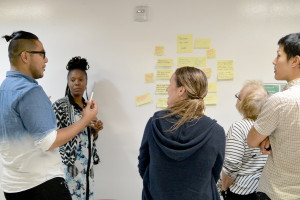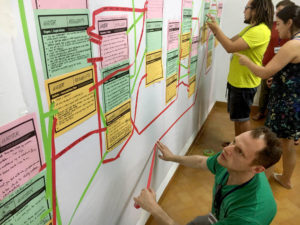September 2017

Carnegie Mellon’s School of Design is proposing a new type of Designer, a new practice for working toward significant, complex issues: Transition Design. I think it’s especially relevant today because the current presidency is shining a light on so many social problems that are not on a healthy trajectory within the U.S. and this administration also manages to challenge any improvements to climate change and other environmental concerns.
In many ways, Transition Design builds on Service or Systems Design and Social Innovation. But what I’m fascinated by is that they aren’t taking the Human Centered Design tools that are familiar to us. They are proposing new tools, new mindsets, and new references to prepare students for truly wicked problems.
From the paper, “Transition Design Overview” by Irwin, Kossoff, and Tonkinwise,
“ The transition to sustainable futures calls for new ways of designing that are based upon a deep understanding of how to design for change and transition within complex systems (Irwin 2011). This knowledge and the new skillsets it will inform must be integrated from areas such as science, philosophy, psychology, social science, anthropology and the humanities and will therefore challenge existing design paradigms.”
https://www.academia.edu/13122242/Transition_Design_Overview
From Cameron Tonkinwise’s entertaining and challenging Medium post, “design thinking, yet again, because, maybe, it could actually be useful, perhaps even necessary, given every thing”
“We are not adequately seeing all these sociotechnical systems. We are missing the designed relations between these systems and our various habits and values that are proving so resistant to change toward more sustainable futures.”
https://medium.com/@camerontw/design-thinking-yet-again
Terry Irwin, Gideon Kossoff, and Cameron Tonkinwise boldly propose that in order to make a dent in these intractable problems, Designers of the Future will need new skills, postures, and foundations apart from traditional design practice, such as:
- Choosing a theme-based career, to stay with problems over time and across disciplines. An avocation, not a vocation.
- Developing less through individual creativity, and more relational discovery (talking to people, learning from experts, pulling in multiple types of information).
- Fostering criticism and resistance. These are activists they are raising over there. Resist the zero-sum, capitalistic drivers.
- More academic learning about theories of change and philosophy of mindsets and belief systems.
- Visioning at significant, long-term levels: radical visions of 2020, 2050 and 2100—because these are the timelines needed to solve many of the wicked problems.
- Therefore, Learning to plan a long-term project. You will only be part of a relay race, not a sprint.
The election last November shook me, as it did so many people. I became fascinated with understanding these “other” voters so that I could see, through their eyes, these issues that seemed so black and white to me. I started to see the complexities in the challenges of American identity, job creation, political accountability. I began to search for books that might explain some of it, and there were a few that helped to describe the problem, but of course, most academics don’t propose solutions. That’s what designers do. But these topics are so much more complicated than the bounded problems we typically work on when there is a client, a set amount of time, a set amount of money and an expected outcome.
What would it mean to work on a design challenge that could take 100 years to solve? 50 years, ok, 20 years, if that helps it feel more plausible.

It turns out that Terry Irwin, the head of the School of Design at Carnegie Mellon is exploring this right now. She has instigated a new practice in Design called Transition Design, which comes out of her Ph.D. research with ecologist Gideon Kossoff, and philosopher turned design professor, Cameron Tonkinwise. The three of them propose that in response to the failure of Ecology and Sustainability to sufficient change behavior and improve attitudes toward more long-term thinking about the earth, Design may be able to help. But only with new tools to handle the complexity, new mindsets to deal with such long-term challenges and new training in systems of change.
I have to admit that I never personally connected with the Green Design movement, so I was surprised to find myself excited about Transition Design. But I think it is because Transition Design can be used to tackle any number of societal issues we face today, and it approaches with a great deal of empathy and a curiosity about the causes and mindsets that are at the root of the problem.
I was invited to attend a 5-day course in Spain with Terry, Gideon, and Cameron. The course had an incredible diversity of attendees: some service designers, some design professors but also community organizers and NGO workers– from all over the world. The attitude these three leaders take is that this discipline of design is just beginning, the same “problem worrying” they apply to Transition challenges, they apply to the development of the tools and methods themselves. It is all work in progress, and they invite us all to try it out and build on what is there.
